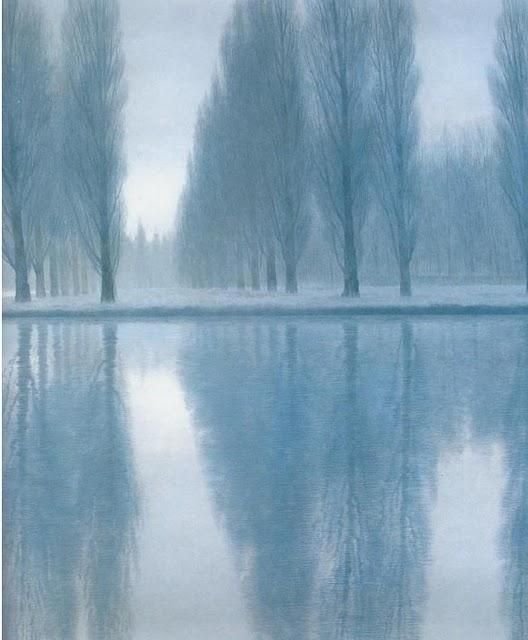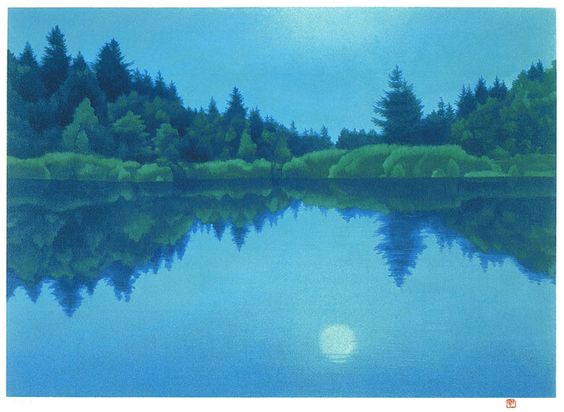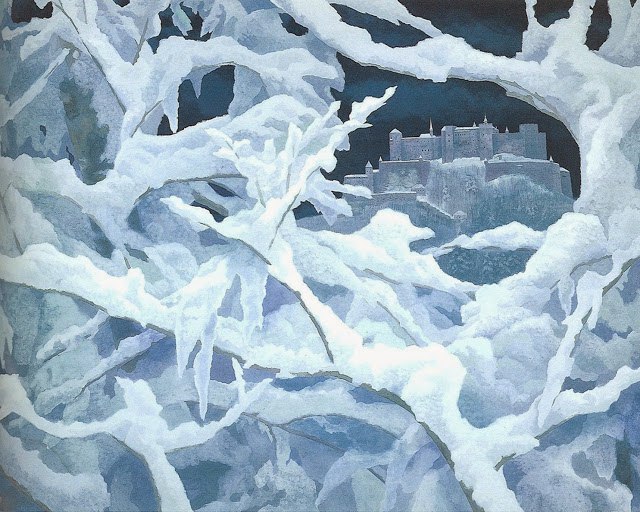 Maybe it is one late afternoon, maybe it is dusk the subject Kaii Higashiyama sketched with tenuous, misty but deep shades of azure in the painting entitled Song of Silence (1981). The exact point in time and space is unresolved, indefinable: it is within the domain of soul, it is in the world of memory and dream. Rows of upwardly directed trees disappearing into the distance are mirrored on the lake. The space extends almost isotropically into the three dimensions: into the side length of the lake, the doubled height of the trees and their reflected image, the depth of the row cluster. Everything, the observer included, seems to breathe deeply and in synchronization, a powerful enchantment made of silent breathe of nature, the sublime song of silence, so solemn, so quiet.
Maybe it is one late afternoon, maybe it is dusk the subject Kaii Higashiyama sketched with tenuous, misty but deep shades of azure in the painting entitled Song of Silence (1981). The exact point in time and space is unresolved, indefinable: it is within the domain of soul, it is in the world of memory and dream. Rows of upwardly directed trees disappearing into the distance are mirrored on the lake. The space extends almost isotropically into the three dimensions: into the side length of the lake, the doubled height of the trees and their reflected image, the depth of the row cluster. Everything, the observer included, seems to breathe deeply and in synchronization, a powerful enchantment made of silent breathe of nature, the sublime song of silence, so solemn, so quiet.
 The shores of a lake were again a setting for the artwork entitled Moon Reflection (1999). Here, the shades of sparkling blue and green make the moonlight effect almost vivid. Instead of being portrayed, the moon is evoked because of its reflection: the absence of that lighty source exercises a suggestion pretty well thought out. According to Shintoism, a single thing is a mirror for all the others, so that the mirroring lake is the moon and the moon is the lake of light.
The shores of a lake were again a setting for the artwork entitled Moon Reflection (1999). Here, the shades of sparkling blue and green make the moonlight effect almost vivid. Instead of being portrayed, the moon is evoked because of its reflection: the absence of that lighty source exercises a suggestion pretty well thought out. According to Shintoism, a single thing is a mirror for all the others, so that the mirroring lake is the moon and the moon is the lake of light.
 In Castle of Snow (1970), nature and civilization face one another: the former and the latter are respectively represented by a snow-covered thorn and a castle into the distance. Almost sounds like the snow itself has build up glowing frozen castles on branches and fronds. The painter adopted the whites for light to be reflected. The branches in the foreground behaves as an excellent viewpoint for framing the remotely positioned castle. This space construction is typical of the Japanese perspective in which a scenery is represented as if the observer is looking behind a visual obstacle. This is, for example, the case for Hiroshige’s woodblock print entitled Plum Park in Kameido (1857).
In Castle of Snow (1970), nature and civilization face one another: the former and the latter are respectively represented by a snow-covered thorn and a castle into the distance. Almost sounds like the snow itself has build up glowing frozen castles on branches and fronds. The painter adopted the whites for light to be reflected. The branches in the foreground behaves as an excellent viewpoint for framing the remotely positioned castle. This space construction is typical of the Japanese perspective in which a scenery is represented as if the observer is looking behind a visual obstacle. This is, for example, the case for Hiroshige’s woodblock print entitled Plum Park in Kameido (1857).
Kaii Higashiyama (8 July 1908 – 6 May 1999) has been a representative of the Nihonga genre. After a remarkable beginning as a young artist of oil paintings inspired by the western art, he was guided by his father towards the purely Japanese Nihonga style. This draws in fact inspiration, as to both subject and technique, from the Japanese art’s traditional movements. The young Higashiyama attended the Tokyo University of Fine Arts and soon was pleased to see that the authored first painting, in the Nihonga style, was accepted for inclusion in the “Nitten” Group’s annual exhibition. Kaii Higashiyama’s vocational training was later supplemented by travel abroad, during which he got a chance to know the artists of the Italian Renaissance, thereby being totally intrigued. He made some trips to Scandinavia, which is why his landscape paintings are influenced, maybe. Either way, Higashiyama’s artworks are affected by the memory of Europe, but also by the landscapes of Japan: moreover, the sea and the moorlands of the Oze plateau surrounded by high mountains in the prefecture of Gumma, where he used to go.
Likewise other Nihonga members, notably Uemura Shoen and Yokoyama Taikan, he lived dramatically throughout the Second World War period. However, he rather expressed preference for picturing books for children than producing patriotically motivated artworks, thus against the artwork trend during those dark years. Higashiyama is not only remembered as an author of paintings on washi paper, but also of fusuma-e murales (in the fashion of the traditional Japanese houses’ fusuma sliding doors) for a Japanese house that was built in Nagoya in 1953 with a view to the opening of a MoMA exhibition in New York City. Further murals were commissioned to him by the Emperor and some wall sceneries in Japanese and Chinese styles, by the Tōshōdai-ji shrine, in years 1975 and 1980.
The artist used to say that a Nihonga painter cannot but work in Japan. In fact, the climate of Japan is humid, hence, it is suitable for the traditional painting with natural pigments having an almost sandy consistency. Kaii Higashiyama’s poetry is entirely founded upon the peculiar Nihonga technique, in turn inspired by the Rinpa art. That poetry is put into practice by creating chiaroscuro-like depth effects through the use of suitably fragmented pigments with varying particle size, thus in alternative to the elsewhere widely adopted color dilution. The dream-like glow settled over Higashiyama’s paintings, with their gentle shades of color, ethereal beauty, interspersed low or vivid light, owe a great deal to the use of pigments according to the centuries-old Japanese tradition.
Copyright © arteingiappone – All rights reserved
Kaii Higashiyama’s artworks are displayed in the
Nagano Prefectural Shinano Art Museum, Higashiyama Kaii Gallery
http://www.npsam.com/
Credits for pictures, respectively:
https://it.pinterest.com/pin/454089574904689428/